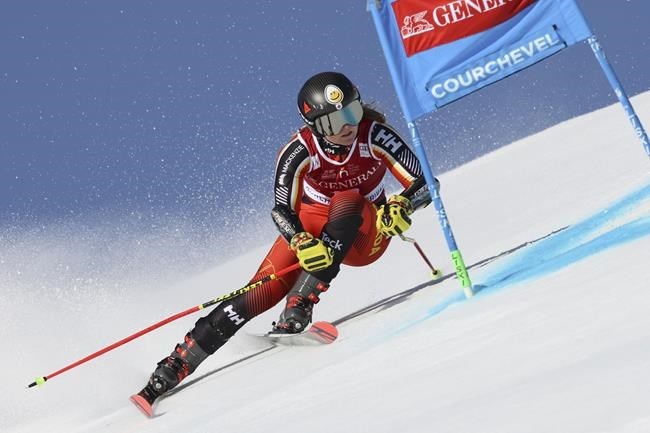Women's World Cup ski racing is coming to Mont-Tremblant, Que.
Alpine Canada and the ski resort northwest of Montreal have conditional approval from skiing's world governing body for annual women's giant slalom races from 2023 to 2025, Alpine Canada said Tuesday in a statement.
Course improvements are underway and test races are scheduled for February and March.
The first double giant slalom races at Mont-Tremblant's World Cup are planned for Dec. 2-3, 2023.
"People at Tremblant have been talking about trying to hold a World Cup there for 15 years," Alpine Canada chief executive officer Therese Brisson told The Canadian Press.
Canada's slalom and giant slalom skiers rarely race at home. Panorama, B.C. was the site of women's slalom and GS in 2007.
"Our women's team, we're so incredibly strong in tech events, yet we didn't have a World Cup," Brisson said.
"Having a tech event was something that was very much a priority, and just so close to Montreal, where there's the Laurentians, and even into Eastern Ontario, there's an amazing fan base that rarely gets to see live World Cup ski racing."
Canada has been a regular stop on the international downhill circuit for three decades.
Lake Louise, Alta., will host men's and women's World Cup downhills and super-G races Nov. 25-27 and Dec. 2-4 respectively for a total of six races.
Two-time Olympian Valérie Grenier of St. Isidore, Ont., is thrilled at the prospect of racing GS, which is her specialty, on the mountain where she learned to ski.
"I'm just so freaking happy," the 25-year-old told The Canadian Press from Italy, where's she's training for Saturday's giant slalom in Soelden, Austria.
"It's a dream come true because every time I see athletes from other countries race at home, when it's their home hill or really close, it just seems so amazing.
"You can tell it means a lot to them and the fans. Now the fact that I'm going to actually experience that, it's just mind-blowing for me."
Tuesday's announcement, and other variables, may impact the future of racing at Lake Louise, which has hosted World Cup racing for 30 years.
The women's GS races in Quebec would overlap Alberta's women's downhills on the same weekend, if the latter remains where it is on the calendar.
Brisson says Alpine Canada remains committed to hosting men's speed races in Western Canada.
The International Ski and Snowboard Association (FIS) has yet to release a race itinerary for 2023-24.
FIS leadership is unsettled. The ski federations of Austria, Germany, Croatia and Switzerland are contesting the re-election of president Johan Eliasch and have taken their appeal to the Court of Arbitration for Sport.
"Whether there will be women's speed on the calendar in North America at all is still to be determined," Brisson said. "My priority is definitely to land men's speed in the west."
An Austrian media outlet reported 2022 was the last year for Lake Louise's World Cup races, citing FIS race director Klaus Waldner.
"It would be premature to say that, for sure," Brisson said. "When I asked resorts who would be interested in hosting a men's World Cup whether it be in early winter in the traditional time-slot, or in February … pleasantly a number of resorts put up their hand and said they were interested.
"Lake Louise is part of that conversation as well."
The men have traditionally opened their downhill season with a North American block of races in Lake Louise and then Beaver Creek, Colo., before heading to Europe.
This season breaks from that ritual, however, with a pair of men's downhills Oct. 29-30 and two women's Nov. 5-6 in Europe.
The start house for those races is in Zermatt, Switzerland and the finish line in Cervinia, Italy for the first cross-border World Cup.
The women's downhills in Lake Louise haven't had other North American speed races adjacent to them on the calendar.
A selling point for Mont-Tremblant was its World Cup falls a week after slalom and GS races in Killington, Vt., which makes for streamlined travel for athletes.
Alpine Canada assumed operational responsibility of Lake Louise's World Cups this year after a decade of management by Winterstart Events.
While Lake Louise is a tried and tested venue, it is expensive to operate those races in a national park, particularly with rising energy costs for snow-making, Brisson said.
"In order to make Lake Louise work, we need the scale of six races, or we have in the past," she stated. "It has probably the highest costs for snow-making in the world."
Whistler, B.C., last hosted men's and women's World Cup downhill, super-G, giant slalom and alpine combined in 2008 as test events for the 2010 Winter Olympics and Paralympics.
There isn't enough terrain at Mont-Tremblant for downhill or super-G races, Brisson said.
"There's a beautiful run that has some nice deep parts for a GS track that finishes right in the village," she said.
This report by The Canadian Press was first published Oct. 18, 2022.
Donna Spencer, The Canadian Press




